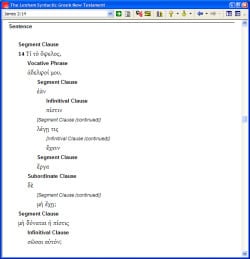- The Lexham Syntactic Greek New Testament
- The Lexham Syntactic Greek New Testament: Sentence Analysis
- The Lexham Syntactic Greek New Testament: Expansions and Annotations
The Lexham Syntactic Greek New Testament
This portion is what we usually refer to as the “running text”. It has the text (that is, the words, casing and punctuation) of the NA27 Greek New Testament. However, the display is broken out to show the basic clausal hierarchy specified by the Lexham SGNT. A screen capture helps one understand this. In this display (click image for full-size) the indentation from the left of the window implies heirarchy. The further the indent, the deeper the structure. A bold heading implies a new clausal unit, an italicised heading implies a continued clausal unit. A horizontal border notes a sentence boundary.
- Manuscript:
This is the form of the word found in the NA27 text.
- Greek Lemma:
This is the dictionary form of the word that you’d look up in a Greek lexicon. It is the form used for keylinking (and for running the Exegetical Guide, the Lemma Report, or the new Bible Word Study Report in the upcoming v3.0)
- Morphology:
This is a string of codes representing the morphological form of the word; including part of speech information, case/number/gender for substantives; tense/voice/mood/etc. for verbs; and the like. In other words, the standard morpho-syntactic information that most morphological databases include.
- Literal Translation:
This is a literal translation of the inflected form of the word. It is taken from the McReynolds Greek-English interlinear.


In the above screen capture, you may notice a reference for “predicate nominative”. The Syntactic Force Annotations for each word are also encoded as references on the manuscript form of the word. This means that right-click functions (such as speed search) could be invoked on these references. Because the word link is established, we could set our preferences up such that the preferred word reference target information displays on hover of the word. Actually, this is the default setting so one gets information hovered (in this case, from the Lexham SGNT Expansions and Annotations) already:


Encoding the syntactic force annotations also means that the Reference Browser can be used to do rudimentary searching for syntactic force annotations. In the Reference Browser, I’ve selected Lexham SGNT as the resource, the Syntax Notes (that is, the Syntactic Force Annoation; these titles will be aligned in a future beta release) as the reference type. Then I simply typed “predicate nominative” in the Find box. Hit enter, and I have a list of locations where this occurs. Clicking on any one will jump to the instance of the reference. For the Lexham SGNT, this means it will jump to the word that the reference is attached to. When click on Hebrews Chapter 2 [Hebrews 2:14], I jump directly to the word ????????.





